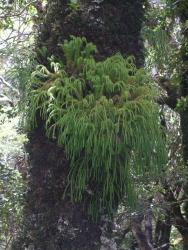Terrestrial or epiphytic plants. Stems erect or pendent, dichotomously branched with branches of equal thickness, lacking horizontal stems. Roots forming a single basal tuft. Leaves spirally arranged, similar or gradually reducing towards the apex; leaf margins entire. Bulbils absent. Sporophylls similar to the leaves or slightly modified, aggregated into more or less distinct strobili, persistent. Strobili terminal on ultimate branches, pendent on epiphytic plants or curved downwards in erect plants, sessile. Spores foveolate or fossulate, triangular in polar view with convex lateral margins, and foveolate sculpture only on the distal surfaces.
A genus of c. 250 species (PPG 1 2016).
The huperzioid clade within Lycopodiaceae includes Huperzia, Phlegmariurus and Phylloglossum (Field et al. 2016). Previously Huperzia and Phlegmariurus were combined in a single genus (Øllgaard 1987), or sometimes included also with Phylloglossum (Christenhusz et al. 2011). However, more recent studies have concluded that Phlegmariurus is distinct from Huperzia, and that three genera should be recognised (Øllgaard 2012; Field & Bostock 2013; Field et al. 2016). New Zealand species of Huperzia and Phlegmariurus were all treated in Lycopodium by Allan (1961).
The huperzioid clade is distinguished by isotomous branching, with all dichotomies resulting in equally thick branches; tufted roots; sporophylls that are either similar to the leaves, or modified, aggregated into strobili and persistent (Øllgaard 1987, 1990; Field et al. 2016); and foveolate or fossulate spores (Tryon & Lugardon 1991, figs 227.1–227.14; Large & Braggins 1991).
Phlegmariurus is distinguished from Huperzia by lacking reproductive bulbils in the sporophyll axils (Øllgaard 1987, fig. 22), having sporophylls that are aggregated into strobili (at least in New Zealand), and spores with convex lateral margins, and foveolate sculpture only on the distal surfaces (Tryon & Lugardon 1991, figs 227.5–227.14). They are either epiphytic pendent plants, or erect terrestrial or rupestral plants (Field et al. 2016). Phlegmariurus is easily distinguished from Phylloglossum, which is a tiny terrestrial plant with a subterranean tuber, a whorl of linear leaves, and a small strobilus borne on a leafless stalk.
Allan (1961) recognised three species in Lycopodium that are here included in Phlegmariurus: L. billardierei, L. novozealandicum and L. varium. However, Brownsey et al. (1985) reduced these to one polymorphic species requiring further investigation. Morphological and molecular analysis of this group by Perrie et al. (2020) has shown that Phlegmariurus billardierei is clearly distinct from P. varius and endemic to New Zealand, but that Colenso’s Lycopodium novozealandicum is just one form of Phlegmariurus varius. Terrestrial and epiphytic forms of P. varius, which were originally recognised as distinct varieties (Brown 1810), are very closely related, and treated here as one species. They occur in Australia as well as New Zealand.
| 1 | Transition from leaf to sporophyll abrupt, strobili distinct; stems (including leaves) 1.5–8 mm wide just before junction with strobilus; longest sporophylls 1.5–3 mm long; strobili 1.5–3 mm wide at widest point | billardierei |
| Transition from leaf to sporophyll gradual, strobili indistinct at proximal end; stems (including leaves) 6–18 mm wide just before junction with strobilus; longest sporophylls 2.5–11 mm long; strobili 3–17 mm wide at widest point | varius |
A large genus found mainly in the tropics and subtropics but with some species extending into the southern temperate zones (Field et al. 2016); nine species in Australia (Chinnock 1998). Two indigenous species in New Zealand; one endemic.
| Category | Number |
|---|---|
| Indigenous (Endemic) | 1 |
| Indigenous (Non-endemic) | 1 |
| Total | 2 |
Chromosome numbers in Phlegmariurus vary from n = 136 to n = c. 278. A possible base number is x = 17, but there are many exceptions (Field et al. 2016).




